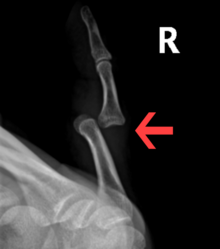| Mr. Ibrahem/Dislocated finger | |
|---|---|
 | |
| X ray of a dislocated PIP joint (dorsal) of the 5th finger | |
| Specialty | Plastic surgery |
| Symptoms | Crooked finger, pain, swelling [1] |
| Usual onset | Late teenage years [2] |
| Types | DIP, PIP, MCP [2] |
| Risk factors | Sports that involve balls, gymnastics [3] |
| Diagnostic method | X-rays [1] |
| Differential diagnosis | Finger fracture, mallet finger [2] |
| Treatment | Joint reduction followed by splinting or buddy tapping for few weeks [4] [3] |
| Frequency | Common [2] |
A dislocated finger is when one of the three joints of the finger is out of place. [2] Symptoms generally include a visibly crooked finger, pain, and swelling. [1] Complications may include ligament or tendon injury, which may result in instability or a boutonnière deformity. [5]
Common causes include sports that involve balls and gymnastics. [3] The underlying mechanism generally involves the finger getting bent backwards. [5] They includes DIP dislocations, PIP dislocations (most common), and MCP dislocation. [2] [5] The most commonly affected MCP joint is that of the thumb. [4] Diagnosis is by X-rays. [1] They can be classified as dorsal, volar, or lateral based on the position of the bone farthest from the body. [2]
Treatment is by joint reduction, which can often be achieved by pulling on the finger. [5] This may be carried out following a ring block of the affected finger; though not always required. [5] [4] Following reduction X-rays are done to verify success and the finger splinted or buddy tapped for a week or two. [4] [3] If splinted, it may be recommended to remove the splint to move the finger daily. [4] When a fracture or instability is also present, management is more complicated. [3] Dislocated fingers are common. [2] They occur most often in the late teenage years. [2]
- ^ a b c d "Finger Dislocations - Injuries and Poisoning". Merck Manuals Consumer Version. Archived from the original on 13 February 2024. Retrieved 20 February 2024.
- ^ a b c d e f g h i Taqi, M; Collins, A (January 2024). "Finger Dislocation". StatPearls. PMID 31855352.
- ^ a b c d e Miller, EA; Friedrich, JB (April 2020). "Management of Finger Joint Dislocation and Fracture-Dislocations in Athletes". Clinics in sports medicine. 39 (2): 423–442. doi: 10.1016/j.csm.2019.10.006. PMID 32115092.
- ^ a b c d e Borchers, JR; Best, TM (15 April 2012). "Common finger fractures and dislocations". American family physician. 85 (8): 805–10. PMID 22534390.
- ^ a b c d e "Finger Dislocations - Injuries; Poisoning". Merck Manuals Professional Edition. Archived from the original on 23 March 2023. Retrieved 21 February 2024.
| Mr. Ibrahem/Dislocated finger | |
|---|---|
 | |
| X ray of a dislocated PIP joint (dorsal) of the 5th finger | |
| Specialty | Plastic surgery |
| Symptoms | Crooked finger, pain, swelling [1] |
| Usual onset | Late teenage years [2] |
| Types | DIP, PIP, MCP [2] |
| Risk factors | Sports that involve balls, gymnastics [3] |
| Diagnostic method | X-rays [1] |
| Differential diagnosis | Finger fracture, mallet finger [2] |
| Treatment | Joint reduction followed by splinting or buddy tapping for few weeks [4] [3] |
| Frequency | Common [2] |
A dislocated finger is when one of the three joints of the finger is out of place. [2] Symptoms generally include a visibly crooked finger, pain, and swelling. [1] Complications may include ligament or tendon injury, which may result in instability or a boutonnière deformity. [5]
Common causes include sports that involve balls and gymnastics. [3] The underlying mechanism generally involves the finger getting bent backwards. [5] They includes DIP dislocations, PIP dislocations (most common), and MCP dislocation. [2] [5] The most commonly affected MCP joint is that of the thumb. [4] Diagnosis is by X-rays. [1] They can be classified as dorsal, volar, or lateral based on the position of the bone farthest from the body. [2]
Treatment is by joint reduction, which can often be achieved by pulling on the finger. [5] This may be carried out following a ring block of the affected finger; though not always required. [5] [4] Following reduction X-rays are done to verify success and the finger splinted or buddy tapped for a week or two. [4] [3] If splinted, it may be recommended to remove the splint to move the finger daily. [4] When a fracture or instability is also present, management is more complicated. [3] Dislocated fingers are common. [2] They occur most often in the late teenage years. [2]
- ^ a b c d "Finger Dislocations - Injuries and Poisoning". Merck Manuals Consumer Version. Archived from the original on 13 February 2024. Retrieved 20 February 2024.
- ^ a b c d e f g h i Taqi, M; Collins, A (January 2024). "Finger Dislocation". StatPearls. PMID 31855352.
- ^ a b c d e Miller, EA; Friedrich, JB (April 2020). "Management of Finger Joint Dislocation and Fracture-Dislocations in Athletes". Clinics in sports medicine. 39 (2): 423–442. doi: 10.1016/j.csm.2019.10.006. PMID 32115092.
- ^ a b c d e Borchers, JR; Best, TM (15 April 2012). "Common finger fractures and dislocations". American family physician. 85 (8): 805–10. PMID 22534390.
- ^ a b c d e "Finger Dislocations - Injuries; Poisoning". Merck Manuals Professional Edition. Archived from the original on 23 March 2023. Retrieved 21 February 2024.